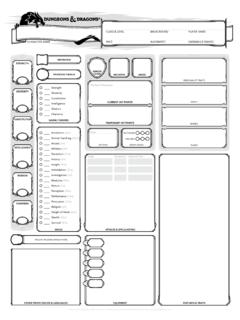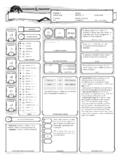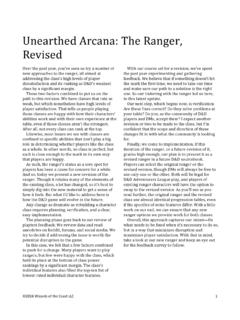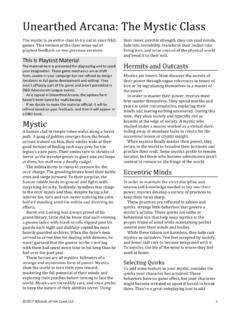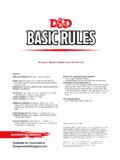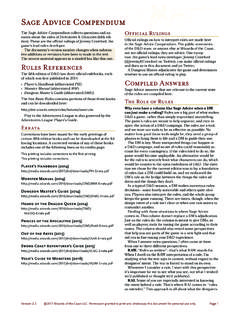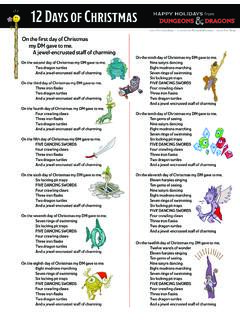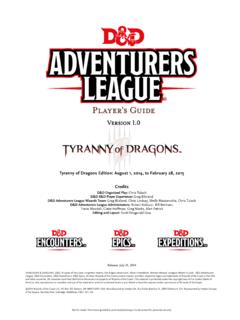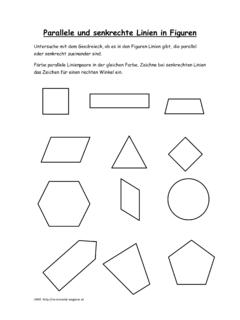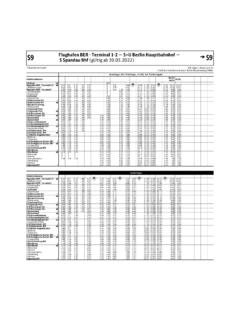Transcription of U A Gothic Lineages - Wizards
1 2021 Wizards of the Coast LLC 1 UNEARTHED ARCANA 2021 Gothic Lineages By F. Wesley Schneider, Ben Petrisor, and Jeremy Crawford, with input from the rest of the D&D design team This Is Playtest Material The material in this article is presented for playtesting and to spark your imagination. These game mechanics are in draft form, usable in your campaign but not refined by full game design and editing. They aren t officially part of the game and aren t permitted in D&D Adventurers League events. The best way for you to give us feedback is in the survey we ll release on the D&D website soon. If we decide to make this material official, it will be refined based on your feedback, and then it will appear in a D&D book. The character options you read here might be more or less powerful than options in the Player s Handbook.
2 If a design survives playtesting, we adjust its power to the desirable level before official publication. This means an option could be more or less powerful in its final form. This document features three new race options to playtest for player characters in D&D: Dhampir Hexblood Reborn These options are special; you can choose one at character creation or at an appropriate time later in a campaign, transforming your character. Creating Your Character At 1st level, you choose whether your character is a member of the human race or of one of the game s fantastical races. Alternatively, you can choose one of the following Lineages . If you choose a lineage , you might have once been a member of another race, but you aren t any longer.
3 You now possess only your lineage s racial traits. When you create a character using a lineage option here, follow these additional rules during character creation. Ability Score Increases When you determine your ability scores, increase one of those scores by 2, and increase a different one by 1. These increases can t raise a score above 20. You follow this rule regardless of the method you use to determine the scores, such as rolling or point buy. If you are replacing your race with a lineage , replace any Ability Score Increases you previously had with these. Languages Your character can speak, read, and write Common and one other language that you and your DM agree is appropriate for the character. The Player s Handbook offers a list of widespread languages to choose from.
4 The DM is free to add or remove languages from that list for a particular campaign. If you are replacing your race with a lineage , you retain any languages you had and gain no new languages. Creature Type Every creature in D&D, including every player character, has a special tag in the rules that identifies the type of creature they are. Most player characters are of the Humanoid type. A race option presented here tells you what your character s creature type is. List of Types. Here s a list of the game s creature types in alphabetical order: Aberration, Beast, Celestial, Construct, Dragon, Elemental, Fey, Fiend, Giant, Humanoid, Monstrosity, Ooze, Plant, Undead. These types don t have rules themselves, but some rules in the game affect creatures of certain types in different ways.
5 For example, the text of the cure wounds spell specifies that the spell doesn t work on a creature that has the Construct or Undead type. Having More Than One Type. Some creatures are of more than one creature type. If an effect works on at least one of a creature s types, that effect can work on that creature. For example, if you are both a Humanoid and an Undead, cure wounds works on you, since the spell works on a Humanoid. 2021 Wizards of the Coast LLC 2 Design Note: Changes to Racial Traits In 2020, the book Tasha s Cauldron of Everything introduced the option to customize several of your character s racial traits, specifically the Ability Score Increase trait, the Language trait, and traits that give skill, armor, weapon, or tool proficiencies.
6 Following in that book s footsteps, the race options in this article and in future D&D books lack the Ability Score Increase trait, the Language trait, the Alignment trait, and any other trait that is purely cultural. Racial traits henceforth reflect only the physical or magical realities of being a player character who s a member of a particular lineage . Such traits include things like darkvision, a breath weapon (as in the dragonborn), or innate magical ability (as in the forest gnome). Such traits don t include cultural characteristics, like language or training with a weapon or a tool, and the traits also don t include an alignment suggestion, since alignment is a choice for each individual, not a characteristic shared by a lineage .
7 Finally, going forward, the term race in D&D refers only to the suite of game features used by player characters. Said features don t have any bearing on monsters and NPCs who are members of the same species or lineage , since monsters and NPCs in D&D don t rely on race or class to function. Moreover, DMs are empowered to customize the features of the creatures in their game as they wish. Dhampir Poised between the worlds of the living and the dead, dhampirs retain their grip on life yet are endlessly tested by vicious hungers. Their ties to the undead grant dhampirs a taste of a vampire s deathless prowess in the form of increased speed, darkvision, and a life-draining bite. With unique insights into the nature of the undead, many dhampirs turn to the lives of adventurers and monster hunters.
8 Their reasons are often deeply personal. Some seek danger, imagining monsters as personifications of their own hungers. Others pursue re venge against whatever turned them into a dhampir. And still others embrace the solitude of the hunt, striving to distance themselves from those who d tempt their hunger. Dhampir Hungers Every dhampir knows a thirst slaked only by the living. This desire is a whisper in the mind, a tinge to the sight, a reflex constantly needing to be suppressed. Those who overindulge their thirst risk losing control and forever viewing others as prey. Those who resist might find exceptional ways of controlling their urges or suppress it through constant, molar-grinding restraint. In any case, temptation haunts dhampirs, and circumstances conspire to give them endless reasons to indulge.
9 While many dhampirs thirst for blood, your character might otherwise gain sustenance from the living. Roll on or choose an option from the Dhampir Hungers table to determine what tempts your character to feed. Dhampir Hungers d8 Hunger 1 Blood 2 Flesh or raw meat 3 Cerebral spinal fluid 4 Esoteric humors 5 Psychic energy 6 A color from one s appearance 7 Dreams 8 Life energy Dhampir Origins Dhampirs often arise from encounters with vampires, but all manner of macabre bargains, necromantic influences, and encounters with mysterious immortals might have transformed your character. The Dhampir Origins table provides suggestions for how your character gained their lineage . Dhampir Origins d8 Origin 1 You are the reincarnation of an ancestor who was a vampiric tyrant.
10 2 Your pact with a predatory deity, fiend, fey, or spirit causes you to share their hunger. 3 You survived being attacked by a vampire but were forever changed. 4 A parasite inhabits your body. You indulge your hunger to sate it. 5 You loved an immortal and were willing to be transformed into a vampire to join them, but tragedy interrupted the transformation. 6 You are a diminished manifestation of an otherworldly being. Slaking your hunger hastens your renewal. 7 You don t know your origins, but you were raised by vampires or other monsters. 8 A radical experiment changed your body, making you reliant on others for vital fluids. 2021 Wizards of the Coast LLC 3 Dhampir Traits Type: Humanoid and Undead Size: Medium or Small (choose when you gain this lineage ) Speed: 35 feet Darkvision.
